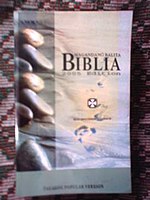Magandang Balita Biblia
This article includes a list of references, related reading, or external links, but its sources remain unclear because it lacks inline citations. (May 2014) |
| Magandang Balita Biblia | |
|---|---|
 | |
| Full name | Magandang Balita Biblia |
| Other names | Magandang Balita Biblia |
| Abbreviation | MBB |
| OT published | 1983 |
| NT published | 1976 |
| Complete Bible published | 1983 |
| Authorship | A Common Tagalog Bible, whose translation is sponsored by the Episcopal Commission on Biblical Apostolate of the Catholic Bishops' Conference of the Philippines |
| Textual basis | Old Testament -- Masoretic Text, New Testament -- GNT 1975, Deuterocanonicals -- Septuagint |
| Translation type | 27.49% paraphrase rate |
| Version revision | 2005 |
| Publisher | Philippine Bible Society |
| Copyright | 2005 |
| Religious affiliation | Ecumenical |
Nang simulang likhain ng Diyos ang lupa at ang langit, ang lupa ay wala pang hugis o anyo. Dilim ang bumabalot sa kalaliman at umiihip ang malakas na hangin sa ibabaw ng tubig. Sinabi ng Diyos:" Magkaroon ng liwanag!" At nagkaroon nga.
Gayon na lamang ang pag-ibig ng Diyos sa sanlibutan, kaya ibinigay niya ang kanyang bugtong na Anak, upang ang sumampalataya sa kanya ay hindi mapahamak, kundi magkaroon ng buhay na walang hanggan. | |
The Magandang Balita Biblia (or the Tagalog Popular Version) is one of the two most widely circulated translation of the Christian Bible in the Tagalog language [the other entitled Ang Bagong Ang Biblia, a revision of the earlier Ang Biblia (meaning The Bible)], first published by the Philippine Bible Society in 1973. This translation of the Holy Scriptures in Tagalog follows the tradition of the Good News Bible, an English language translation published by the American Bible Society in 1966.
However, the Magandang Balita Biblia is not a translation of the Good News Bible but only a parallel translation of it. Also, like the tradition of the Good News Bible, some publications features line drawings of Biblical events with a snippet of text.
Also, unlike other Tagalog translations, the 'Magandang Balita Biblia' also tried to translate the verse parts of the Bible in verse form, making it more singable when set to music.
Popularity
As there are but a very few translations of the Holy Scriptures in Tagalog, the 'Magandang Balita Biblia' has easily become a very popular version in the Philippines and the Filipino diaspora. Its version of the Psalms was used as the official text of the Catholic Liturgy of the Hours in Tagalog. It is also widely used by those of other denominations in church services and Bible Studies.
Sources and bases
According to the Philippine Bible Society, the translators used the Masoretic Texts as the main basis of their Old Testament. However, when there was no satisfactory text that could be used as a basis, the PBS opted to use any of the oldest versions available. These versions are those written in Greek, Syriac or Latin. However, when there still was no other version available, the committee opted to use a modern translation that they deemed suitable.
For the Deuterocanonical Books, the translator used the Septuagint as the sole basis. Particularly, they used the one that was published in 1949, which was edited by Alfred Rahlfs. However, for comparative purposes, the PBS used the Biblia Sacra (published 1969) which was prepared by Robert Weber.
When it comes to the New Testament, the Translators used the Greek New Testament (published 1975), same for some parts that was based on a variant reading supported by one or more Greek manuscript.
Features and translation method
The Magandang Balita Biblia is the first Tagalog Bible to use the dynamic equivalence technique. Its aim was to give more emphasis to meaning than to form. Unlike the earlier Ang Biblia, this translation of the Bible used weights and measures that were more familiar to Filipino readers.
Since there was a trend towards Filipinisation during the Marcos Era (the time when the Biblia was published), it was just expected that there was a tension regarding the use of borrowed words. This was, however, changed in the 2005 Edition of the Biblia when the translators chose words like "bag" instead of the more traditional "sisidlán" ("[small] container").
The translators used the more ecumenical "Yahweh" for the tetragrammaton YHWH. This is because Filipinos associated the name "Jehovah" with Protestant leanings (specifically because of the Bible published by Jehovah's Witnesses). Another reason for doing this is to eliminate the confusion on instances where the term "YHWH Elohim" is used; this is translated as "Panginoong Yahweh".
As is the practice in all the Bible translations in the Philippine languages, place names and personal names followed their Spanish counterparts.
The new revision as of 2005, changed some proper names such as Nabucadnosor and Esdras to the semi-anglicised and more recognisable Nebucadnezar and Ezra, respectively. Likewise, the new revision has its footnotes added and had also interspersed the deuterocanonical books in its Catholic versions.
Likewise, some words found in the 1980 edition, such as patutot (prostitute), pakakak (trumpet), saserdote (priest), and lebadura (yeast) were considered archaic and 'deep' (with some of Spanish origin) and changed to the more contemporary babaeng nagbebenta ng aliw ("woman selling amusement", a euphemism), trumpeta, pari (originally used for Christian priests), and pampaalsa ("that which causes rising").
Liturgical usage
Being an ecumenical translation, the liturgical usage of the first edition was upheld by the Catholic Church in the Philippines. This is also the recognised text of most denominations that use Tagalog in the Liturgy, such as the Iglesia Filipina Independiente and the Episcopal Church in the Philippines.
See also
References
- http://tipan.wordpress.com/about/
- http://www.angbiblia.net (2005 edition)

